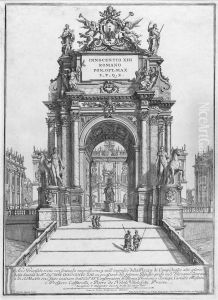Francesco Faraone Aquila Paintings
Francesco Faraone Aquila was an Italian engraver and printmaker born in Palermo, Sicily, in 1676. He is recognized for his skillful adaptations of paintings by renowned artists into engravings, which played a significant role in spreading the styles and themes of the Italian Baroque and Rococo periods beyond the confines of Italy. His works are characterized by their detailed execution and the ability to capture the essence of the original paintings, making him a notable figure in the history of European printmaking. Aquila's career flourished in the early 18th century, a period marked by the flourishing of the arts across Europe. He moved to Rome, the epicenter of artistic innovation, where he immersed himself in the vibrant artistic scene. In Rome, Aquila had the opportunity to study and interpret the works of masters such as Raphael, Carracci, and Poussin. His engravings served not only as artworks in their own right but also as a means of disseminating the masterpieces of Italian art to a wider audience, including patrons and art enthusiasts who could not travel to see the original works in person. Aquila's contributions to the art world were not limited to his engravings; he also played a role in the artistic community as a mentor and influencer, nurturing the next generation of artists and engravers. Throughout his career, Francesco Faraone Aquila collaborated with prominent artists and patrons, contributing to important projects and commissions that further established his reputation. Despite the high regard in which he was held during his lifetime, detailed records of his life and work are somewhat scarce, leading to challenges in fully appreciating the extent of his impact. Nonetheless, his surviving works continue to be studied and admired for their technical proficiency and artistic beauty. Francesco Faraone Aquila died in 1740, leaving behind a legacy that has endured as an important part of the history of engraving and printmaking.
![[classical Statues]: Eight Plates](https://www.niceartgallery.com/imgs/369611/s/francesco-faraone-aquila-classical-statues-eight-plates-e782c80d.jpg)
